©
2004 Jeff Matthews & napoli.com
Dubbing
(film)
This
model of Oliver Hardy is on via S. Gregorio Armeno. The Italian
voice of Ollie was Alberto Sordi. It was a spectacularly successful
example of dubbing.
|
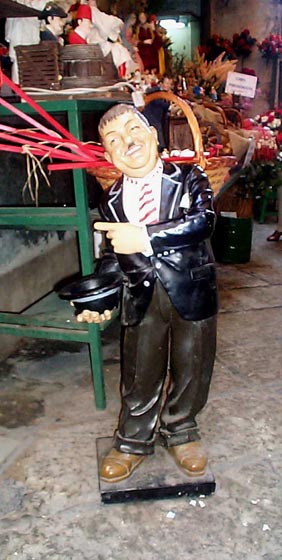 I
was watching a skit with Neapolitan comic Massimo Troisi the other night
on TV. Although I should know better, I was upset that I didn't understand
the uncompromisingly authentic Neapolitan dialect. There were, however,
subtitles to make the dialect intelligible to viewers from elsewhere in
Italy who might be watching. For a long time, I had assumed that foreigners
were the only ones who had such troubles. Not so. Italian dialects can
vary considerably from standard Italian, so it is common to see such films
with subtitles. I
was watching a skit with Neapolitan comic Massimo Troisi the other night
on TV. Although I should know better, I was upset that I didn't understand
the uncompromisingly authentic Neapolitan dialect. There were, however,
subtitles to make the dialect intelligible to viewers from elsewhere in
Italy who might be watching. For a long time, I had assumed that foreigners
were the only ones who had such troubles. Not so. Italian dialects can
vary considerably from standard Italian, so it is common to see such films
with subtitles.
Interestingly,
that is about the only time in Italy that you see subtitles in films.
Foreign films—unlike Italian dialect films—are always dubbed
into Italian. Films are dubbed so well and so consistently in Italy,
that it is common for a single dubber to shadow the career of a foreign
actor for years. For example, with your back turned to the screen, even
if the film is in Italian, you know that Woody Allen is speaking, because
his dubber is always Italian comic Oreste Lionello. If Marlon Brando,
Robert Redford and Paul Newman all sound the same in Italian, it's because
the same dubber, Giuseppe Rinaldi, does all three of the voices.
Emilio Cigoli does both John Wayne and Clark Gable, so you may actually
have to turn around and look at the screen to find out if you're watching
Stagecoach or Gone With the Wind.
Dubbing
a film is much more expensive than simply slapping subtitles at the
bottom of the screen. Dubbing involves a sound studio, hiring voices
for each character and doing take after take in an attempt to get the
original inflecions into a voice, and then making sure that the new
language synchronizes as well as possible with the lip movements on
the screen. Nothing is worse than bad dubbing, where the emotions of
the voice don't fit the action, and where the synchronization is so
out of whack that half the time the actors look like poor souls on street
corners making silent fish-like mouth movements to themselves.
The biggest
reason why Italians choose to dub films rather than subtitle them goes
back to when "talkies" started in the late 1920s. In a nation dealing
with drastic differences in dialects, dubbing was a way to help create
a sense of a single national language. Thus, even Italian actors with
easily identifiable regional accents have been dubbed into more "standard"
Italian. (At the beginning of her career, Sophia Loren was dubbed, apparently
because of her regional accent from Pozzuoli, near Naples.) Interestingly,
after two decades of good dubbing, Italians were so used to standard
Italian in films, that when the wave of post-WW II Italian films known
as "Neo-Realism" came in, with their dialogues recorded live in Sicilian,
Neapolitan and Roman dialects, it came as a shock to many Italians to
realize that they didn't really understand many of their own countrymen.
("Precisely the point," said more than one Neo-Realist director.)
Italian
dubbing is generally so consistent that mimics regularly "do" foreign
actors who have characteristic vocal styles—say, John Wayne or
Jimmy Stewart. Such attention is paid to quality dubbing that Greta
Garbo, for example, upon hearing herself in Italian for the first time,
sat down and wrote a fan letter to her Italian voice, owned by actress
Tina Latenzi. And some dubbing, of course, requires the same unusual
verbal dexterity as the original voice—witness the tongue-twisting
pyrotechnics of Stefano Sibaldi, the Italian voice of Danny Kaye.
Perhaps
the strangest sidelight in this whole matter is that dubbed voices can
become part and parcel of another culture, evoking allusions and inside
jokes just as do the original voices in their own culture. The Italian
voices of Stan Laurel and Oliver Hardy are the best example of this.
When talkies came in, Laurel and Hardy had already achieved world-wide
fame on the basis of their short silent movies. There was such a new
demand for them speaking, however, that for a time they actually reshot
their scenes hurriedly in other languages, pronouncing their lines
from scripts written in phonetic English. These scenes would then
be sent abroad to be spliced into the rest of the film, which had been
remade in the target language using local actors. That soon proved impractical,
especially for longer feature films. Consequently, for the Italian market
the decision was made to dub the films of Laurel and Hardy in American
studios using Italian-American actors, who, presumably, thought they
were speaking standard Italian. Their own Italian, however, had been
maimed by at least one generation of nasal semi-vowels, unrolled r's
and Wrigley's Spearmint.
When the
studios in Rome reviewed the first dubbed-in-America Laurel and Hardy
film to see what they had, the American English accented voices were
so hilarious, that someone came up with the idea of redubbing
everyone else into normal Italian, but leaving Stan and Ollie with accents.
There followed a nation-wide contest to find the voices of Laurel and
Hardy in Italian. One winner was the now famous Italian comic, Alberto
Sordi, whose career started as the voice of Oliver Hardy. His anglicized
Italian as 'Ollie' has become so much a part of Italian popular culture
that an Italian, today, can do Oliver Hardy by saying, with a broad
English language accent, "stupido " (accenting the second, instead of
the first, syllable, in imitation of Sordi's version of Oliver Hardy)
and have it recognized as instantly as an English-speaker would recognize,
"Well, here's another fine mess you've gotten me into!" Indeed,
Italian mimics still regularly pay tribute to Laurel and Hardy, imitating
the dubbed voices. (The Italian voice of Stan Laurel was Mauro Zambuto,
who, after WW II, moved to the United States and became a professor
of Electrical Engineering at the New Jersey Institute of Technology.)
So, without
taking anything away from the universal nature of the humor of Laurel
and Hardy, it is fair to say that in Italy, much of their popularity
was—and still is—due to the spectacularly successful way
they are dubbed. There is no Italian comic (not even the great Totò)
who, by voice alone, is as recognizable as are Laurel and Hardy in Italian.
The only competition in recognizability might be the Italian voice of
Donald Duck! Most of the voices in those cartoons are, indeed, dubbed
into relatively normal Italian—except for Donald. He still quacks,
but his Italian dubber is none other than Clarence Nash, the original
English voice of Donald Duck for the Disney studios and who dubbed himself
into many foreign languages—including Japanese. Apparently, Nash
was one of the few persons to have truly mastered the difficult trick
of compressing air in the cheek cavity and producing articulate quacks.
(Phoneticians call this the "buccal voice". To the rest of us, it's
known as "duckspeak".)
Anyway,
gotta run. I hear the sultry, breathless tones of Rosetta Calavetta
on the tube. Marilyn Monroe, to you.
Diplomatic
Relations, US/Naples (1); Hammett, A.
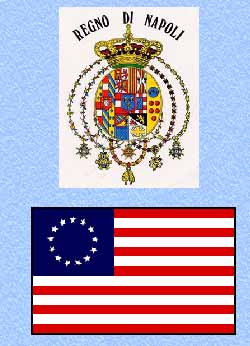 Quite
by accident I came across an item the other day from December, 1996.
It was a press statement from the U.S. State Department commenting on
the anniversary of the establishment of diplomatic relations between
the USA and the Kingdom of Two Sicilies. In part, it said: Quite
by accident I came across an item the other day from December, 1996.
It was a press statement from the U.S. State Department commenting on
the anniversary of the establishment of diplomatic relations between
the USA and the Kingdom of Two Sicilies. In part, it said:
| This
Day in Diplomacy: Establishment of Diplomatic Relations
With the Kingdom of the Two Sicilies on December 16, 1796.
Today
the city of Naples will commemorate the 200th anniversary of
the establishment of diplomatic relations between the United
States and the Bourbon Kingdom of the Two Sicilies of which
Naples was capital. The rapid expansion of American trade in
the Mediterranean basin and a growing regional instability created
by the French revolution and North African piracy required an
expanded diplomatic and military presence in the region by the
fledgling American government. Naples, as the largest
city on the Italian peninsula, was a major port of call for
American merchant vessels. Moreover, the Bourbon regime
still enjoyed in the last years of the 18th century its reputation
as one of the pioneering reform states of the European Enlightenment.
Until
most of Italy was united in 1861 as the Kingdom of Italy, the
United States maintained separate diplomatic and consular representatives
at Naples. Continuous U.S. diplomatic representation at the
court of the Two Sicilies only began in 1831, and then, in keeping
with the cautious regard of American republicanism toward European
monarchies, such representation was almost always a Charge d'Affaires
rather than a full Minister. American commerce, however,
made necessary continuous consular representation at Naples
from 1796. For 52 years, from 1809 until 1861, Alexander Hammett
of Maryland served continuously as American consul at Naples.
During his long tenure, Hammett reported on wars, revolutions,
and the expansion of U.S. trade.
|
I was in
Naples in December 1996, and I'm sure I would recall any large-scale
popular celebrations of the anniversary of the establishment of relations
between the USA and the Kingdom of Two Sicilies (also known as the Kingdom
of Naples). There were none—not even any clandestine humming of
the Bourbon Royal March. No doubt, this has to do with the fact that
said kingdom went out of business in 1860.
Alexander
Hammett sounds like an interesting person, though. He represented the
US in Naples for over half a century. The dates invite further investigation
that I shall have to get around to sooner or later. If he started his
tenure in 1809, that would be in the middle of the short reign of Murat, who ruled for Bonaparte during what is still
called the "The Decade" in Neapolitan history. When Murat was
deposed in 1814, it seems that Hammett simply stayed on as US representative.
That strikes me as unusual.
The first
mention of relations between the new American nation and Naples is in
the National Archives in Naples. A Neapolitan businessman, one Vincenzo
Cutini, made a request on March 12, 1783, to be appointed Consul in
the United States. That date is interesting in that it is before the
Treaty of Versailles officially ended the American Revolution, meaning
there really was no United States of America, yet. The King of
Naples, however, decided that the time was not yet ripe and Cutini's
request was turned down. Over the next two years, Thomas Jefferson,
John Adams and Benjamin Franklin all actively pursued the cause of Neapolitan
recognition of the US. Though diplomatic recognition did not result
from any of this manoeuvring, a somewhat informal period of commerce
ensued. Also, in 1785 the US, concerned about danger to its merchant
fleet in the Mediterranean at the hands of the Barbary pirates, requested
aid, if the need should arise, from the Neapolitan fleet.
By 1796,
the position of the United States had consolidated and it was in that
year that John Mathieu became the first American Consul in Naples. He
was followed in 1806 (the year that Murat took over Naples) by Frederick
Degan, who served until 1809, at which time Alexander Hammett became
Consul and then Charge d'Affaires when full diplomatic relations were
established in 1834. In November 1860, the US diplomatic legation was
closed as the kingdom of Naples was officially annexed to the rest of
Italy. Consular representation in Naples continued, but Hammett was
dischared by the new Lincoln administration. One source I have read
refers to him as "a gifted amateur" and another tells me that he died
in the "almshouse". That would be a sad end. If he left a diary, I wonder
if it is in the National Library downtown. As much as I hate to fight
my way into that place, this one is tempting.
Posillipo
(2); Seiano Grotto (2); Vedius Pollio (villa)
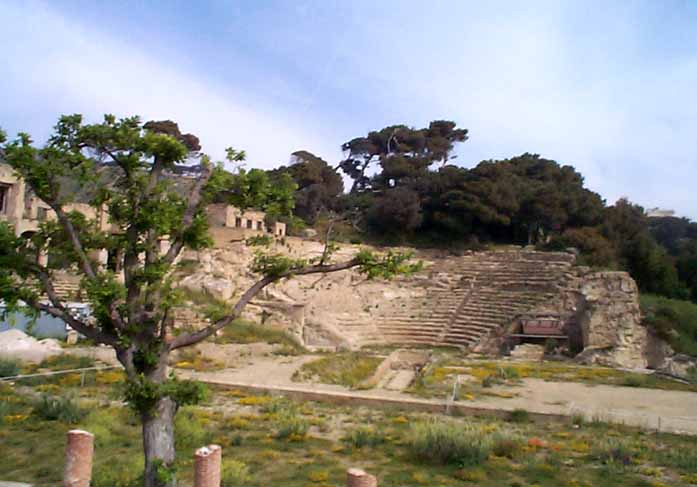 I finally got the opportunity to take a tour through the Seiano Grotto). We started at the Coroglio (Bagnoli)
side and traversed the 700-meter tunnel to come out on the Posillipo
side and then walked up and looked at the Imperial Villa of Pausylipon. I finally got the opportunity to take a tour through the Seiano Grotto). We started at the Coroglio (Bagnoli)
side and traversed the 700-meter tunnel to come out on the Posillipo
side and then walked up and looked at the Imperial Villa of Pausylipon.
The information
in the other entry (linked above) is essentially correct, but needs
some amplification. The name "Seiano" may be a misnomer for this impressive
bit of engineering. The tradition that links the construction of the
tunnel to the will of Lucius Aelius Sejanus, Tiberius' ambitious right-hand
man and would-be successor, is probably wrong. More recent archaeological
thought on the matter connects the gallery to Vedius Pollio, the builder
of the spectacular villa, itself. The tunnel was a private passage for
Pollio so he wouldn't have to take the long way home.
Pollio
was an ex-slave from Benevento known for his industriousness, ambition,
economic wheelings and dealings in North Africa and subsequent great
wealth, and cruelty to his own servants. His villa is mentioned in a
number of classical references as a worthy rival in luxuriousness to
even the fabled villa of Lucullus, a few miles down the coast in what
was Neapolis, itself. It was only after Pollio's death that the premises
passed to Caesar Augustus, apparently in exchange for a promise by the
emperor to honor Pollio's name with a public building in Benevento—a
promise that Augustus reneged on. (Who knows why? Maybe Augustus just
didn't like Pollio. There is one story that says that Pollio was about
to put to death a servant who had just broken a dish. Houseguest Caesar
Augustus was so appalled that he bought the servant and his entire family
from Pollio and took them with him back to Rome—after ordering
that the rest of Pollio's crockery be smashed. (Name a building after
you? I don't think so.)
When Augustus
came into possession of the property, the tunnel then became part of
the public network of roads that connected the important port of Pozzuoli
to Naples, much like its sister tunnel
that joined Fuorigrotta to Naples (near what is today the Mergellina
train station), and only then that the premises became an "imperial"
villa. There are signs that the estate was still an imperial residence
under Hadrian (the early 2nd century) and that the tunnel itself was
in use as late as the fall of the empire, itself—the late 6th
century. After that, it disappears from history until 1840 when the
Bourbons rediscovered the Coroglio entrance to the gallery while doing
some road building of their own. The tunnel was sealed in the 1980s
and then reopened in the 1990s for the restoration that finished just
two years ago.
The imperial
premises start a hundred yards or so from the exit of the tunnel up
a slope toward the cliff, itself. They consisted of a residence, temple,
amphitheater (capacity about 2,000), an odeon (a covered theater), and
a nympheum (a shrine), all spread over a considerable area directly
beneath the height of Cape Posillipo. One view is to that cape and the
bay of Pozzuoli beyond, including the small island of Nisida and the
larger island of Ischia miles away. The western panorama is toward Naples,
Vesuvius, and Capri. "Breathtaking" doesn't begin to cover it.
What one
sees today (photo at top), however, in the way of remnants of imperial
splendor is shabby, indeed— and this is not just due to the ravages
of time. The residence was rediscovered at about the same time as the
tunnel, and, almost immediately, someone built a large private villa
directly above the main amphitheater, using much of the original masonry
for construction material. That villa is now abandoned and totally in
ruins, and the adjacent amphitheater shows the ravages of that original
depredation plus another century and a half of looting. Almost none
of the looted marble and statuary has wound up in proper museums.
It is not
clear whether this Roman estate was built on the site of earlier Greek
structures or not. One interesting item that says "maybe" is the fact
that the rows of seats in the amphitheater are hewn out of the stone
itself—in the manner of Greek amphitheaters—rather than
being freestanding. All of that remains to be determined as restoration
goes forward. The property, itself, is now partially in private hands,
but restoration continues on that part of the property that has reverted
to the cultural offices of the state. The plans are ambitious. So far,
the amphitheater has been cleared of rubble and the small odeon has
been restored such that a small public can enjoy performances of one
sort or another during the summer months overlooking the coast of Posillipo.
Piedigrotta
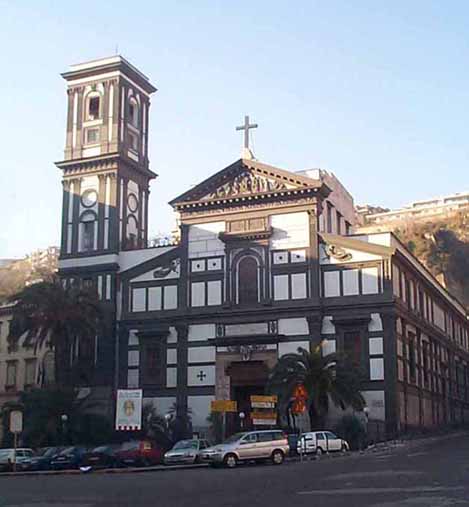 In a culture that abounds with famous place names such as "Santa
Lucia" and "Vesuvius," "Piedigrotta" still stands out as
one of the best-known names among Neapolitans, themselves. The name,
itself, means "at the foot of the grotto," referring to the nearby Roman tunnel that leads beneath the hill
in back of the church of Santa Maria di Piedigrotta; that grotto connects
the section of Naples known as Mergellina at the west end of the
bay with Fuorigrotta —"beyond the grotto," today a thriving and
large suburb of Naples. The old Roman tunnel was bypassed many decades
ago by a modern traffic tunnel on the right of the church. In a culture that abounds with famous place names such as "Santa
Lucia" and "Vesuvius," "Piedigrotta" still stands out as
one of the best-known names among Neapolitans, themselves. The name,
itself, means "at the foot of the grotto," referring to the nearby Roman tunnel that leads beneath the hill
in back of the church of Santa Maria di Piedigrotta; that grotto connects
the section of Naples known as Mergellina at the west end of the
bay with Fuorigrotta —"beyond the grotto," today a thriving and
large suburb of Naples. The old Roman tunnel was bypassed many decades
ago by a modern traffic tunnel on the right of the church.
[See
here and here for more about
tunnels.]
Newspaper
from 1885 featuring the Festival of Piedigrotta
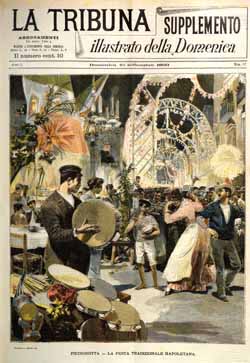 Piedigrotta
is connected in popular Neapolitan culture with the famous "Festival
of Piedigrotta", a celebration on September 8, a spectacular parade
led by viceroys and Kings, passing along the entire length of
the seaside road, Riviera di Chaia, and winding up at the church, itself.
The parade was a yearly affair in the 1600s under the Spanish (who built
the road leading to the church as they expanded the city to the west)
and in the 1700s under the Bourbons. It was still held during the 19th
century. Piedigrotta
is connected in popular Neapolitan culture with the famous "Festival
of Piedigrotta", a celebration on September 8, a spectacular parade
led by viceroys and Kings, passing along the entire length of
the seaside road, Riviera di Chaia, and winding up at the church, itself.
The parade was a yearly affair in the 1600s under the Spanish (who built
the road leading to the church as they expanded the city to the west)
and in the 1700s under the Bourbons. It was still held during the 19th
century.
Beginning
in the 1830s, the Festival of Piedigrotta held a song-writing contest
for composers of Neapolitan songs and
is responsible for providing us with such songs as "Funicuì-Funiculà" (the winner from
1880) and many others. Much more recently, although there is still a
celebration at the church, the parade is no longer held.
The church
of Santa Maria di Piedigrotta is first mentioned in a document from
1207 and is mentioned prominently by both Boccaccio and Petrach in the
1300s. Over the centuries, the church has been redone and expanded many
times. The current façade of the church is from the 1850s. There
is also an adjacent monastery that now serves as a military hospital.
Also, near the entrance to the grotto (above) and behind the church
is a monument billed as Virgil's Tomb.
Perhaps
the most interesting thing, historically, has to do with the site, rather
than the church. That is, the grotto led to the fabled Phlegrean Fields, the mythological entrance to Hades,
and thus lent itself well to mysterious carryings-on. Pre-Christian
religions almost certainly used the site near the present church as
a place for their rituals. One speculation—by no less than the
great Neapolitan dialect poet, Salvatore Di Giacomo (citing "scholarly sources")—is
that here was the setting of Petronius' Satyricon, that great
bit of pornography from the first century a.d. Di Giacomo starts to
cite the passage about the three young men out for a good time going
into the cave and running into a band of women. Then, he blushes to
continue. As do I.
Caracciolo,
F.
Portrait
of Caracciolo by an unknown artist
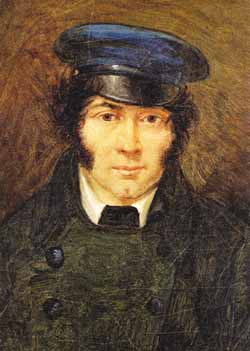 "Caracciolo"
is an old and prominent Neapolitan surname. There are at least 50 bearers
of that name in the current Naples phone book. Indeed, the name has divided
into various branches over the centuries—"Caracciolo–of–here"
and "Caracciolo–of–there," resulting in some very impressive
listings in the directory. There is a "Prince Landolfo Amrogio Caracciolo
di Melissano". That is the longest one I see, although, without a title,
Francesco Alberto Caracciolo di Torchiarolo" edges him out by a few letters.
(From the address in the phone book, he is my next-door neighbor, although
I don't know why that should matter to me.) "Caracciolo"
is an old and prominent Neapolitan surname. There are at least 50 bearers
of that name in the current Naples phone book. Indeed, the name has divided
into various branches over the centuries—"Caracciolo–of–here"
and "Caracciolo–of–there," resulting in some very impressive
listings in the directory. There is a "Prince Landolfo Amrogio Caracciolo
di Melissano". That is the longest one I see, although, without a title,
Francesco Alberto Caracciolo di Torchiarolo" edges him out by a few letters.
(From the address in the phone book, he is my next-door neighbor, although
I don't know why that should matter to me.)
There are
even four different streets named via Caracciolo in Naples: Batistella
Caracciolo (renowned painter of the Neapolitan Baroque, contemporary
of Ribera and Caravaggio); Bartolomeo Caracciolo, about whom I know
nothing; T. Caracciolo (the T stands for Tristan, I think); and the
one that all Neapolitans think of when they hear the name "Caracciolo"
—Francesco. The splendid road that runs from Mergellina to Piazza
Vittoria along the sea, fronting the Villa Comunale, thus, is named
for Francesco Caracciolo (1752-1799), the Neapolitan admiral whose named
is dramatically linked in history with the rise and fall of the Neapolitan
Republic of 1799 and with the principal players in that episode: Queen
Caroline, King Ferdinand, Lady Hamilton, and, especially, Horatio Nelson.
(What follows may be read as an adjunct to other entries about that
period: The Bourbons, part 1; Eleonora
Fonseca Pimentel; and Cardinal Ruffo.)
Francesco
Caracciolo was born January 18, 1752 of a noble Neapolitan family. He
entered the navy at a young age and fought with distinction with the
Kingdom of Naples' ally, the British, in the American Revolutionary
War. He also fought the Barbary pirates and against the French at Toulon.
In December of 1798, the Neapolitan monarchy fled the capital in the
face of the insurgent Neapolitan republican forces backed by the French
army at the gates of the city. The King and Queen fled to Sicily on
Nelson's ship, the "Vanguard", escorted by Caracciolo on the Neapolitan
frigate "Sannita".
Caracciolo
returned to Naples in January to take care of private matters and arrived
in the city after the Republic had been declared. His behavior at that
point has remained the subject of speculation. Either he resented being
snubbed by King Ferdinand, who had fled aboard Nelson's vessel and not
Caracciolo's, or he was appalled at the cowardly flight, itself, or
he was truly taken with the newly proclaimed Neapolitan Republic. Whatever
the case, he took command of the naval forces of the new Republic. In
other words, he betrayed his king.
The
church of Santa Maria della Catena, the final resting place of Admiral
Caracciolo.
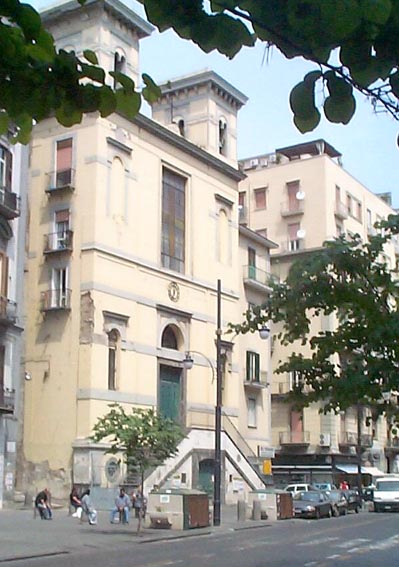 He led the Republican
navy against royalist Neapolitan and British naval forces for the brief
life of the Republic, his last major engagement being an attack on the
British flagship, the Minerva, inflicting damage on that vessel.
The Republic, however, was doomed by the withdrawal of French forces
from Naples and by the arrival of the royalist Army of the Holy Faith
under Cardinal Ruffo. Caracciolo was captured. His trial is a matter
of record and takes place against the whole backdrop of deceit by which
the Royalist forces actually retook the city. The agreed to an armistice,
promised safe passage to Republican defenders (presumably including
Caracciolo), and then put the Republicans on trial, anyway. He led the Republican
navy against royalist Neapolitan and British naval forces for the brief
life of the Republic, his last major engagement being an attack on the
British flagship, the Minerva, inflicting damage on that vessel.
The Republic, however, was doomed by the withdrawal of French forces
from Naples and by the arrival of the royalist Army of the Holy Faith
under Cardinal Ruffo. Caracciolo was captured. His trial is a matter
of record and takes place against the whole backdrop of deceit by which
the Royalist forces actually retook the city. The agreed to an armistice,
promised safe passage to Republican defenders (presumably including
Caracciolo), and then put the Republicans on trial, anyway.
There was
never any doubt as to Caracciolo's fate. Queen Caroline had relayed
to Nelson her wish that Caracciolo should hang, no matter what. Caracciolo
was tried aboard a British ship, the Foudroyant, by Neapolitan
royalist officers and charged with high treason. He was not permitted
to call witnesses in his defence. He was condemned to death by three
votes to two. He was not given the customary twenty-four hours for personal
matters of the spirit. His request to be shot was denied and he was
hanged from the yardarm of the Minerva on the morning of June
30, 1799. His body was weighted and thrown into the sea.
One of
the mainstays of modern Neapolitan mythology is that the body refused
to sink, floating to the surface and eerily bobbing its way towards
shore. Indeed, there is even a painting showing King Ferdinand aboard
his ship, aghast at the sight of the admiral's corpse floating alongside.
Whatever the case, Caracciolo's body was retrieved from the sea and
his remains now rest in the small church of Santa Maria della Catena
in the Santa Lucia section of Naples.
Cucceius
Auctus, Lucius
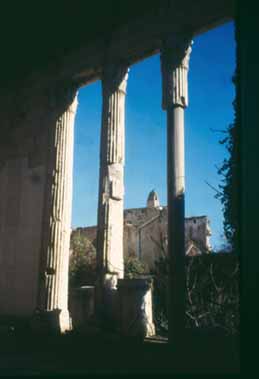 There
was an interesting documentary on television last night about the underwater
remains of Portus Iulius, the port for the Roman Western Fleet. The
coastline and sea-level have changed in two-thousand years and much
of the original port is now underwater in the bay of Pozzuoli. I have
been scuba diving in that area and recall some of the submerged bits
and pieces of what was once the most important port for the greatest
fleet in the world. Then, I head a name: "Lucio Cocceio," the architect,
the builder. I had heard that name before. There
was an interesting documentary on television last night about the underwater
remains of Portus Iulius, the port for the Roman Western Fleet. The
coastline and sea-level have changed in two-thousand years and much
of the original port is now underwater in the bay of Pozzuoli. I have
been scuba diving in that area and recall some of the submerged bits
and pieces of what was once the most important port for the greatest
fleet in the world. Then, I head a name: "Lucio Cocceio," the architect,
the builder. I had heard that name before.
Indeed,
Lucius Cucceius Auctus was apparently the architect, designer,
and builder under Caesar Augustus. By his accomplishments, he is hardly
to be matched in history. He built the original Pantheon in Rome in
27 b.c. He built four major tunnels in the area of Naples: the so-called
"Neapolitan Crypt," the tunnel that connected the port of Pozzuoli and
the adjacent area of the Phlegrean Fields with the city of Neapolis;
the "Gallery of Peace," which joined Lake Averno to fleet facilities
at Cuma; a tunnel that joined Lake Averno to nearby Lake Lucrino; and
the ("Seiano Grotta")—all this in addition to the
entire Portus Iulius, itself. Also, I
was wandering around the recently excavated old city of Pozzuoli. The
cathedral of Pozzuoli burned in 1964 and, lo and behold, they found
that it had been built over the "Temple of Augustus" (photo). The temple
was built at the behest of a rich merchant, one Lucius Calpurnius, during
the age of the August One—and built by Lucius Cucceius Auctus.
I am sure
that there were other prominent feats of engineering and construction
performed by Cucceius, except I don't know what they are. I was sort
of hoping to find an exhaustive—or even an exhausted—biography.
So far, no luck.
Art,
modern; Kapoor, Anish
 The
city of Naples—in its never-ending quest to bring art to the masses
and especially to the masses who ride the subway to work—is not
just going to spruce up the soon-to-be-finished university station at
Monte Sant'Angelo with a few paintings or statues or even bronzed old
jalopies disguised as installation art. They have hired British/Indian
artist Anish Kapoor to turn the entire station, itself, into a work
of art. The station will be among the deepest in Italy (about 40 meters)
and—well, the area is in the Phlegrean Fields, not far from the
mythological descent into Hades— so, says Kapoor: "We want to
create the impression of a Dantean descent into the underworld." No
one seems to know exactly what that means, and few are in a hurry to
find out. It's hell getting to work, anyway. The
city of Naples—in its never-ending quest to bring art to the masses
and especially to the masses who ride the subway to work—is not
just going to spruce up the soon-to-be-finished university station at
Monte Sant'Angelo with a few paintings or statues or even bronzed old
jalopies disguised as installation art. They have hired British/Indian
artist Anish Kapoor to turn the entire station, itself, into a work
of art. The station will be among the deepest in Italy (about 40 meters)
and—well, the area is in the Phlegrean Fields, not far from the
mythological descent into Hades— so, says Kapoor: "We want to
create the impression of a Dantean descent into the underworld." No
one seems to know exactly what that means, and few are in a hurry to
find out. It's hell getting to work, anyway.
Neapolitans
are most familiar with Kapoor from his gigantic site sculpture, Taratantara,
originally created for the new Gateshead's Baltic Centre for Contemporary
Arts in England in 1999, but then set up in Piazza Plebiscito (photo)
in Naples in December of 2000 as that year's contribution to the annual
exposition of installation art of one sort or another (see
here). The title is meant to be echoic of the sound made by a trumpet
fanfare, as in Roman poet Quintus Ennius' line, "At tuba terribili
sonitu taratantara dixit" — ("But the trumpet sounded with
its terrible taratantara", the onomatopoeia usually left untranslated).
Indeed, the sculpture suggests two funnel-like trumpet bells joined
and flaring out to both ends, something like those strange geometric
figures that scientists use to describe what sort of transdimensional
hyperspace thing (a technical term) we shall have to traverse if we
ever hope to reach the stars. Taratantara was made of a shiny
red membrane, glittered in the sun, was about 50 meters long, 20 high
and anchored in Piazza Plebiscito by steel columns at each end. While
it was up, the columns were scaled by demonstrators. They weren't out
to damage the sculpture—and didn't—but the offices of the
Naples Prefecture bounds the north side of the square and that's always
a good place to have a demonstration.
I am reminded
of a clipping I read once in the paper:
| An
English art student's work was thrown out, literally, after an
official at a Birmingham art center mistook it for trash from
the opening day party. Ceri Davie's "Piece de Resistance"
involved red jellies displayed on plates and was intended as a
metaphor of decay. ‘Months of hard work had just gone to
waste,’ the artist said. "I was quite horrified. |
Very few
of us realize the tough row that artists have to hoe in dealing with
Philistines such as that art center official. This is probably because
practical hoes weren’t even invented until the Middle Ages. As
far as we know, the Philistines just got down on all fours and grubbed
their rows into shape with their hands.
Many years
before the Decadent Red Jelly affair referred to above, one of the artist’s
earlier works, Empty Paper Picnic Plate—which consisted
of an empty paper picnic plate— was not all well received by critics,
who found the title too hard to say five times real fast and who also
mistook "empty paper" as a metaphor of life instead of a Minimalist
description of paper picnics, the plate itself being just a secondary,
but sardonic, appliquè —which is just as well, since
it too was given the old heave-ho. Fortunately (maybe), it was saved,
since the art center official who tossed it, threw it into what he thought
was a trash bin, but which, in fact, was also past of the art show.
And then
there was the artist’s Hamburger, those little pointillist
nibbles of semi-conceptualist cholesterol-laden ground Bœuf,
a yummy but still youthful version of her later, futuristic, Quarter-Pounder
With Cheese, in which patrons of the art show were required to flip
burgers in the kitchen, then ask themselves in the drive-through microphone
if they “would like fries with that?” and then—ah,
the stochastic power of it all!—eat or not eat the work of art!
How was the artist to know that they had scheduled the exhibit in the
same hall as a dog show? It was to her credit as a resourceful master
of Performance Art that she retitled the whole thing, Gone to the
Dogs, A Metaphor. (Or Maybe It’s a Simile).
Davies
is not the only artist who has had this trouble. Fortunately, I am in
the possession of a section of the diary of Michelangelo (the National
Library knows nothing about this):
| January
8, 1504. Dear diary. I’m ruined. After years of work in
chipping away the pieces, I have finally figured out where
beauty is, and it’s not in chubby women with smiling faces.
I busted my hump on this one, too! (Alas, even in a society where
males with humps are considered good omens, there is not much
use for a sculptor with a busted one, I’m afraid.)
I
spent three years on this! A veritable mountain of chips, shards,
bits, detritus, little stone chunks lying where they fell, all
at different odd angles, each one with a special metaphor to
it, deconstructing, as it were, the sordid and complex
confusion of our times. And in stone! —in Carrara marble
as eternal as the plots, counter-plots and intrigues that surround
us. I was going to call it something like Plots, Counter-Plots
and Intrigues. (Ok, I hadn’t given it that much thought,
yet.) I figured it was about time someone put it all into permanent
artistic form. Why paint anymore?! The colors will just fade
and then someone will come along and invent cartoonists and
hire one of them to touch up my Sistine Chapel with paint-by-the-numbers
Day-Glo!
So
I finish it and leave it outside. Where else am I going
to keep it, in my living room? This morning it’s gone.
Those morons took the waste rock and put it on display! ‘It
looks just like a boy with a slingshot. Cool!’ they said.
And my work of art? ‘Oh, that crap? We threw it away,’
they said.
I
was talking about this with Leonardo From Vinci (man, what a
one-horse burg that dump is!). He has strung an invention of
his, a ‘talk gizmo’ between his house and mine —two
ceramic cups and a very long thread. It works all right, except
that since our houses are many miles apart, communication kind
of breaks down when Tuscan peasant women somewhere in between
start hanging laundry on the line. He says he’s
working on a very long thread on a spool, which would actually
let you converse as you walk around the street. Like I’m
going to hold my breath waiting for that one. He asked me what
I was doing wasting my time with rocks, anyway, when I could
building things he called ‘aeroplanes’. He told
me he was undecided about what to paint on the part he called
the ‘fuselage’ — an eagle carrying lightning
bolts in its talons or a chubby women with a smiling face. I
suggested a smiling woman holding lightning bolts. He was not
amused. A weird man, Leo. Frankly, I don’t think
the old geezer is playing with a round boccie ball,
anymore. But time will tell.
|
I'll see
your metafour and raise you five.
Risorgimento
Garibaldi's
triumphant entry into Naples
|
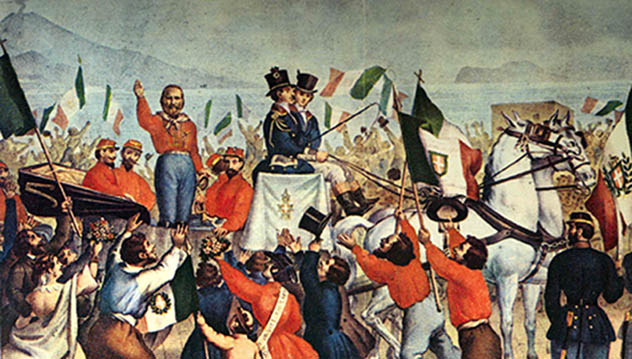
I had lunch
today with a 95-year-old gentleman named Franco. He told me that his
father passed away in the 1950s, also at a ripe old age. We did some
quick figuring and determined that his father was born in 1867. That
was the year that Marx published Das Kapital, the year in which
The Beautiful Blue Danube was played for the first time, and
the year in which the British North American Act created the Dominion
of Canada. The typewriter was invented in 1867 and it was the year that
Czar Alexander II sold Alaska to the United States. Rome was not yet
the capital of a united Italy. I was one generation removed from all
that. (Somehow, all that makes me feel very young rather than very old.
That seems strange.)
I am in
the midst of a "pump the elderly for information" campaign about the
situation in southern Italy following the unification of Italy—that
is, in the decade following the unification in 1861, the year in which
Piedmont, Lombardy, Parma, Modena, Lucca, Romagna, Tuscany, and the
former Kingdom of the Two Sicilies (of which Naples was the capital)
were united under Piedmont's Victor Emmanuel II to form the modern nation
state of Italy. (Rome would become the capital in 1870).
The reason
for my campaign is the few enquiries I have received about northern
mistreatment of the south following unification—or—to use
the terminology of those southerners who express themselves vehemently
about that period, the "rape of the south". There certainly is no shortage
of material in Naples on the subject. I have even seen a book about
"the Savoy concentration camps," in which the title uses the Nazi term
"Lager" (from Konzentrationslager) just so you don't miss
the point. I am looking now at a book entitled They Were the Real
Bandits, those Brothers of Italy. The title contains an allusion
to the first line of the Italian national anthem, known as The Hymn
of Mameli (after the author of the text, Goffredo Mameli, 1827-49).
The line starts, "Fratelli d'Italia…" (Brothers of
Italy), that phrase being the alternate title of the anthem, itself.
The music is by Michele Novaro (1818-85). This particular book is a
condemnation of all the figures popularly connected with the Risorgimento,
the movement to unify Italy; that is, Garibaldi is little more than
a thug in charge of a band of mercenaries, all in the hire of northern
hyenas such as Cavour and Victor Emmanuel II. The defeat of the Kingdom
of the Two Naples (The Kingdom of Naples) by the forces of Garibaldi
and Victor Emmanuel was the beginning of mass unemployment and general
misery for the south and the beginning of immigration away from the
former Kingdom of Naples, thus depleting its greatest resource, people
who want to work. And so on and so forth.
I didn't
get much from Franco, except something I already knew—the Risorgimento
is sacrosanct in modern Italian history. You may take issue with the
way it was done—that is, you may say something like "The unity
of Italy (Risorgimento) was inevitable, but perhaps the invasion
and conquest of the south was not. Maybe it could have been handled
in another way."—but you can't argue with the premise that Italy
was to be one. The term, itself—Risorgimento—rebirth,
resurgence, resurrection (all that)—is the name that Cavour gave
to the newspaper he founded in 1849. In the opening paragraph of the
first issue, he spoke of the need for a "political and economic risorgimento".
The name stuck and became the name of the movement, itself, to unify
Italy.
It would,
however, be a mistake to view that movement strictly as the idea of
northerners such as Garibaldi, Cavour, and Mazzini. Indeed, much of
the philosophy underlying Italian unity comes from the south, from the
members of the so-called Neapolitan Enlightenment such as Vincenzo Cuoco. Indeed, the first secret societies
agitating for unity were the "carbonari", a southern invention. Thus, the drive
to unity was broadbased. Could it have been achieved in any other way
than by an invasion of the south? (The what-if school of history is
always fun!) It turns out that on a least two occasions, Victor Emmanuel
proposed an alliance with the Kingdom of Naples. He and the Neapolitans
would divvy up the peninsula. Since this would entail taking over the
Papal States (except for the city of Rome, itself), the King of Naples
turned down the proposal as blasphemous. And, thus, Garibaldi did what
he did—invaded Sicily and then
the Italian mainland. He disobeyed Victor Emmanuel, by the way. "Don't
invade the mainland," was the order. Garibaldi wrote a nice note, asking
for permission to "disobey". It is not clear that he waited for the
return mail.
Thus—according
to these books I am looking at—began a ten-year period of intense
suffering for the south: looted treasury, industrial plants carried
off, unjust imprisonment and even execution of Neapolitan citizens,
etc. As I say, Franco was no help, other than to tell me that his grandfather—born
in the 1840s—was a proud member of the Bourbon army of the Kingdom
of Naples. I have one more gentleman on my list of those to be pumped.
He is 105 years old. He is in good health, but now says he is feeling
tired. Lunch next week—I hope—but I have the feeling that
I may have to find a real historian.
Miseno
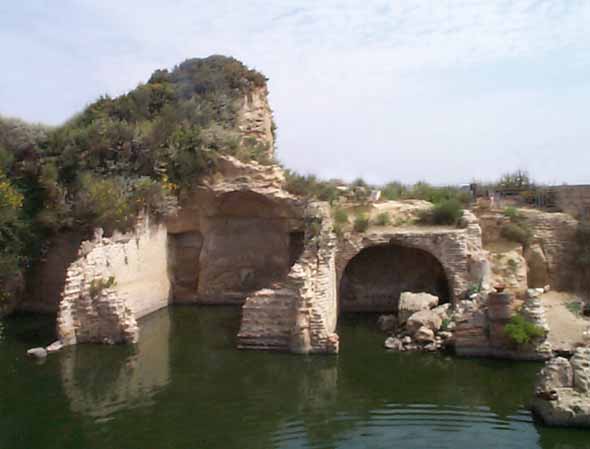 The woman next to me was complaining that "the ruins we saw in Libya
are much better preserved than these." We were standing in what
amounts to ruins of ruins of ruins at Miseno, at the extreme western
end of the Gulf of Naples, in the middle of what used to be Portus Iulius, the home port for the western Imperial
fleet under Caesar Augustus. She was right, of course, but then antiquity
holds up pretty well in the desert air. Libya, too, is about six times
larger than all of Italy and has fewer people in it than I can see from
my balcony in Naples. The woman next to me was complaining that "the ruins we saw in Libya
are much better preserved than these." We were standing in what
amounts to ruins of ruins of ruins at Miseno, at the extreme western
end of the Gulf of Naples, in the middle of what used to be Portus Iulius, the home port for the western Imperial
fleet under Caesar Augustus. She was right, of course, but then antiquity
holds up pretty well in the desert air. Libya, too, is about six times
larger than all of Italy and has fewer people in it than I can see from
my balcony in Naples.
The specific
ruins she was groaning about are a theater, at one time an amphitheater
with the spectator seats—row upon row—set in the side of
the cliff overlooking the outer harbor of the port—now called
"Lake Miseno," such that the spectators had their backs to the hillside
and, beyond the cliff, the water. Of course, we couldn't see any of
that because the concave recess that was once the amphitheatre is full
of modern houses, some of which actually incorporate Roman masonry.
We were actually in the manmade cavern beneath the theater, a passageway
running the perimeter of the semicircular structure above and—two-thousand
years ago—allowing entrance from the waterfront, itself. In order
to get in there, we walked through someone's front yard and down some
stairs by the driveway and garage. (Presumably a concession the owner
has to make to the Ministry of Culture for being permitted to have his
bathroom take up aisle IV, seats XII through XXVI.)
Part of
the problem—no, all of the problem—is that very little of
this was discovered until the 1960s, when overbuilding went absolutely
wild, what with everyone wanting to ride the Italian economic miracle
to the outskirts and live high up overlooking the bay where, yea, brave
Ulysses sailed, and only a few hundred yards from where some of the
juiciest parts in The Aeneid are supposed to have played
out.
Archaeologists
have discovered and excavated what is left of a sacello (a small
shrine, see photo, above) built to Caesar Augustus, but any appreciation
of that, as well, has to contend with adjacent apartments. Certainly,
in an area of Italy with abundant and open displays of ancient Rome,
such as Pompeii and Herculaneum, and even ancient Greece, such as Cuma
and Paestum, it is strange to prop yourself up against a bus-stop so
you can try to shoot around the rubbish bin for a good shot of a shrine
to the emperor.
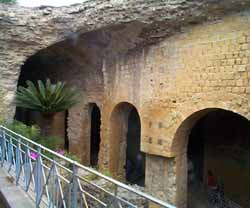 Relatively
unspoiled, however, and high at the top of the cliff over the bay is
the Cento Camarelle -the One Hundred Little Rooms (photo, left)-
a group of cisterns arranged on two levels oriented at right-angles
to each other. Whether or not there are really one-hundred chambers,
I don't know, but the entire labyrinth is impressive and cut out of
the tuff of the cliff. The passageways between the individual cisterns
are narrow and none of the entire affair is for the claustrophobic.
The walls are still plastered with the waterproof plaster called
cocciopesto and there are graffiti on those walls from those
who have visited before you. One I saw was from "1737". Besides the
two accessible levels, there is evidence of another one even deeper.
The great Neapolitan archaeologist, Amedeo Maiuri, suggested that much
of the structure was originally a basement of sorts for a private villa,
possibly that of the orator Quintus Hortensius Ortalus (114–50
b.c), public-speaking rival of Cicero, himself. That is speculative,
of course, but, in any event, that would place any private villa on
the spot well before the time at which the premises were eventually
given over to the service of the later imperial port under Augustus. Relatively
unspoiled, however, and high at the top of the cliff over the bay is
the Cento Camarelle -the One Hundred Little Rooms (photo, left)-
a group of cisterns arranged on two levels oriented at right-angles
to each other. Whether or not there are really one-hundred chambers,
I don't know, but the entire labyrinth is impressive and cut out of
the tuff of the cliff. The passageways between the individual cisterns
are narrow and none of the entire affair is for the claustrophobic.
The walls are still plastered with the waterproof plaster called
cocciopesto and there are graffiti on those walls from those
who have visited before you. One I saw was from "1737". Besides the
two accessible levels, there is evidence of another one even deeper.
The great Neapolitan archaeologist, Amedeo Maiuri, suggested that much
of the structure was originally a basement of sorts for a private villa,
possibly that of the orator Quintus Hortensius Ortalus (114–50
b.c), public-speaking rival of Cicero, himself. That is speculative,
of course, but, in any event, that would place any private villa on
the spot well before the time at which the premises were eventually
given over to the service of the later imperial port under Augustus.
Aragonese Naples—
The
white section between the towers is called
the Aragonese Victory Arch
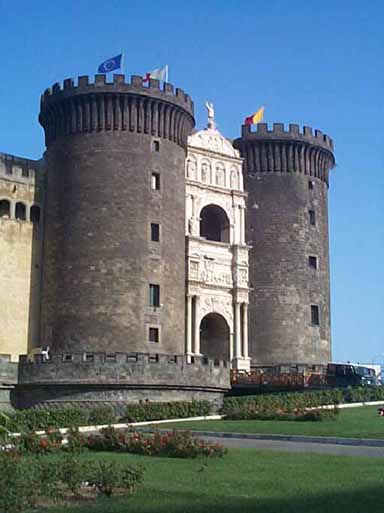 "I
wonder how they got in! " people would say. It had worked for
the Greeks against the Trojans and it had even come off once before
in this very city of Naples back in the 6th century when
the Byzantine general Belisarius sneaked his men past the city walls
through an aqueduct. Now it was going to work again; Alfonso's cohorts
within the city opened the passage and let the invaders in. And just
as under Belisarius, the subsequent sacking and pillaging was atrocious,
but Naples was now rejoined to Sicily, unifying the Kingdom of Two Siciles
for the first time in two hundred years. Afterwards, Alfonso went back
outside so he could enter the city officially on 26 February 1443
in a golden chariot and sheltered by a canopy held by 30 disgruntled
Neapolitan noblemen. That entry is memorialized in the Aragonese victory
arch over the entrance to the Maschio Angioino , the Angevin Fortress (photo, left).
It was a task they did not like, for a king they did not like, at the
beginning of a dynasty they would not like. Shortly thereafter, Alfonso
left his Spanish holdings to his brother and dedicated himself full-time
to his own Aragonese dynasty in Italy. "I
wonder how they got in! " people would say. It had worked for
the Greeks against the Trojans and it had even come off once before
in this very city of Naples back in the 6th century when
the Byzantine general Belisarius sneaked his men past the city walls
through an aqueduct. Now it was going to work again; Alfonso's cohorts
within the city opened the passage and let the invaders in. And just
as under Belisarius, the subsequent sacking and pillaging was atrocious,
but Naples was now rejoined to Sicily, unifying the Kingdom of Two Siciles
for the first time in two hundred years. Afterwards, Alfonso went back
outside so he could enter the city officially on 26 February 1443
in a golden chariot and sheltered by a canopy held by 30 disgruntled
Neapolitan noblemen. That entry is memorialized in the Aragonese victory
arch over the entrance to the Maschio Angioino , the Angevin Fortress (photo, left).
It was a task they did not like, for a king they did not like, at the
beginning of a dynasty they would not like. Shortly thereafter, Alfonso
left his Spanish holdings to his brother and dedicated himself full-time
to his own Aragonese dynasty in Italy.
Neapolitans
always considered Alfonso a foreigner, particularly because of his habit
of surrounding himself with only his own countrymen and giving them
the choice positions at court. Apparently, towards the end of his life
he changed his mind about this and passed on to his son a few
bits of advice: avoid the Spanish, lower the taxes and keep on good
terms with the princes in Italy, especially the Popes. Alfonso was regarded
as a cultured person; he founded an excellent library, and artists,
poets, philosophers and scholars were an integral part of his court.
In the field with his troops, he lived the same life as his men and
exposed himself to danger in battle with no regard for his own
personal safety. They say he also went among the common people incognito
to find out how things were going. He liked to listen rather than
talk and claimed to be a simple person, once saying he would have been
a hermit if he had had his choice in life.
Alfonso
of Aragon
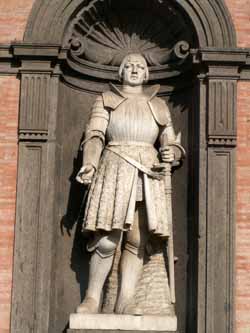 Because
of his patronage of the arts he became known as Alfonso the Magnanimous.
He also started the total rebuilding of the Angevin Fortress, fallen
into ruin since its completion in the late 1200s; he paved the
streets of the city, cleaned out the swamps and greatly enlarged the
wool industry that had been introduced by the Angevins. In spite of
his pretensions to simplicity, however, he was addicted to splendor.
At a Neapolitan reception for Frederick III of Germany, the order of
the day to all the artisans in the Kingdom was to give Frederick's men
whatever they wanted and send Alfonso the bill. Then they all went hunting
in the great crater known as the Astroni in the Phlegrean
Fields and had a banquet at which wine flowed down the slopes and
into the fountains for the guests. Parties, however, did not prevent
Alfonso, by the time of his death in 1458, from also having developed
the Kingdom of the Two Sicilies into the foremost naval power in the
western Mediterranean. Because
of his patronage of the arts he became known as Alfonso the Magnanimous.
He also started the total rebuilding of the Angevin Fortress, fallen
into ruin since its completion in the late 1200s; he paved the
streets of the city, cleaned out the swamps and greatly enlarged the
wool industry that had been introduced by the Angevins. In spite of
his pretensions to simplicity, however, he was addicted to splendor.
At a Neapolitan reception for Frederick III of Germany, the order of
the day to all the artisans in the Kingdom was to give Frederick's men
whatever they wanted and send Alfonso the bill. Then they all went hunting
in the great crater known as the Astroni in the Phlegrean
Fields and had a banquet at which wine flowed down the slopes and
into the fountains for the guests. Parties, however, did not prevent
Alfonso, by the time of his death in 1458, from also having developed
the Kingdom of the Two Sicilies into the foremost naval power in the
western Mediterranean.
Alfonso's
illegitimate son, Ferrante, succeeded him, and in spite of extreme hostility
on the part of the feudal lords in the kingdom, succeeded in strengthening
the monarchy at their expense. He also drove the Angevin fleet from
Ischia, their last stronghold in the area. Ferrante countered baronial
hostility most violently. To show the barons that feudalism was truly
dead he made a lot of them dead, by doing things such as inviting
them to weddings and then arresting, jailing and executing a number
of them. They say that some were fed to a crocodile that prowled the
dungeon. (A skeleton of one such reptile hung over the arch in the Castle
until quite recently.) He even mummified some of his late enemies and
kept them on display in the dungeon of the Castelnuovo (the alternate
name for the Maschio Angioino, meaning, simply "New Castle",
thus distinguishing it from the older Castel
dell'Ovo, the Egg Castle).
A sigh
of relief went up from the landholding class when Ferrante died in 1494
after 28 years on the throne. It had been a time of intrigue that included
on-again / off-again relations with the Church and even a short-lived
treaty with the feared Turks who were raiding up and down the Italian
coasts. The point of the treaty had been to warn the rest of Italy to
the north not to take the Kingdom of Naples for granted. (The Ottoman
Turks had just overrun the Byzantine Empire and were threatening Rome,
itself.)
Charles
VIII
 The French
reappeared with designs on the throne of Naples. Under Ferrante's
successor, Neapolitan resistance to the French was utterly ineffective
and the French, under Charles VIII, took the city virtually unopposed;
indeed, they were welcomed by most of the nobility, who sensed
a chance to recoup their losses. Their toadying didn't work. The French
pillaged the city, anyway, and dispossessed a number of the nobles.
Charles, however, suddenly found himself cut off: The Papal State, Milano,
and Venice —which had just let Charles pass through unhindered
on the way to Naples— suddenly formed an alliance behind and against
him. Charles had to fight his way back home, attempting along the way,
and failing, to bribe the Pope into crowning him King of Naples. The
jibe by historians is that the French brought two things back from their
Italian campaign: the Renaissance and syphilis, one of which history
has dubbed morbus gallicus in their honor. The French
reappeared with designs on the throne of Naples. Under Ferrante's
successor, Neapolitan resistance to the French was utterly ineffective
and the French, under Charles VIII, took the city virtually unopposed;
indeed, they were welcomed by most of the nobility, who sensed
a chance to recoup their losses. Their toadying didn't work. The French
pillaged the city, anyway, and dispossessed a number of the nobles.
Charles, however, suddenly found himself cut off: The Papal State, Milano,
and Venice —which had just let Charles pass through unhindered
on the way to Naples— suddenly formed an alliance behind and against
him. Charles had to fight his way back home, attempting along the way,
and failing, to bribe the Pope into crowning him King of Naples. The
jibe by historians is that the French brought two things back from their
Italian campaign: the Renaissance and syphilis, one of which history
has dubbed morbus gallicus in their honor.
France
then tried something else: the proposal of an Alliance to Ferdinand
of Spain against Spain's own Aragonese relatives in Naples, by virtue
of which the Kingdom of Two Sicilies would cease to exist and be divided
between Ferdinand and Charles. This would effectively give them both
one less rival realm in the area, as well as squelch the heresy that
it wasn't nice to carve up one's own cousins. Ferdinand went for it
and even Machiavelli, himself, later said that Ferdinand had certainly
needed no lessons from anyone in ruthless princemanship. The pact
of Granada was signed on November 11, 1500; the Kingdom was to be divided,
with the capital, Naples, going to France. The French reentered Naples
in July 1501. It now seemed, however, that both France and Spain
had had their fingers crossed at the signing of the original treaty,
so they had a war over it and Spain won. In May 1504, Spanish troops
evicted the French and entered Naples, ending the Aragonese dynasty,
and the Kingdom, intact, became a colony of Spain.
Naples
was now no longer the capital of its own realm. In a few year's time,
with Charles V of Spain crowned Holy Roman Emperor, heir to the Caesers
and Charlemagne, it would be part of an empire, as it had been
more than a thousand years earlier. True, the East had fallen and
what was left of Christian Empire was all in the West; but after 1492,
"West" meant something monumentally different in human history. The
Empire had shifted, spreading from Europe to the Americas
and on to the Pacific. The age of Empires on which "the sun never sets"
had arrived.
Gypsies
(1)
 I
gave a few cents to a gypsy kid who was playing the accordion on the
subway this evening. He wasn't all that bad. He looked to be about 15
or 16 and played a good, competent version of a Russian folk song, the
name of which I don't remember. He smiled as he played and was not oppressively
obnoxious about trying to wheedle money out of you. I
gave a few cents to a gypsy kid who was playing the accordion on the
subway this evening. He wasn't all that bad. He looked to be about 15
or 16 and played a good, competent version of a Russian folk song, the
name of which I don't remember. He smiled as he played and was not oppressively
obnoxious about trying to wheedle money out of you.
There didn't
used to be any accordion players in Naples. Now they are a major import
item and seem to be in all the trains. The real reason I gave the kid
some money was to reward him for being the first gypsy squeeze-boxer
I have heard who has not played that annoying "Anniversary Waltz". It
seems to be the only song they know, and most of them never get past
the first 16 measures— "Oh, how we danced on the night we were
wed/ We vowed our true love, though a word wasn't said…" Then
they diddle around, lose the rhythm, play some wrong notes and start
again.
I wonder
if they are real gypsies from Romania. That song is known as The
Anniversary Waltz (or Song) to English-speaking audiences
and bears the names of Al Jolsen and Saul Chaplin on the music. Jolsen
recorded it in 1946. It is, however, "borrowed" from the music of Josef
Ivanovici, a Romanian composer (1845-1906); it is part of his Waves
of the Danube waltz suite.
Cops,
undercover
 Today
was the beginning of Operation "High Impact". There were so many "Forces
of Order" (as Italian so wishful-thinkingly dubs the various branches
of law enforcement)—also known as "cops" for purposes of this
brief discussion—on the streets of downtown Naples this morning
that at least a few bad guys were scared off and most tourists thought
they had wandered onto the set of Rambo XII. Today
was the beginning of Operation "High Impact". There were so many "Forces
of Order" (as Italian so wishful-thinkingly dubs the various branches
of law enforcement)—also known as "cops" for purposes of this
brief discussion—on the streets of downtown Naples this morning
that at least a few bad guys were scared off and most tourists thought
they had wandered onto the set of Rambo XII.
These weren't
delicate traffic cops handing out tickets. They wore flak jackets and
carried automatic weapons. The pulled over suspicious looking cars,
and the word is that they confiscated all sorts of contraband by so
doing; also, they turned up a lot people without driving licenses or
documents and a few out driving around who should apparently have been
at home since they were under house arrest for some reason. I did see
one bored and heavily-armed cop stop an attractive young woman on a
motorcycle because she wasn't wearing a helmet. The gist of the conversation
was that he would really hate to see something terrible happen to her
beautiful head just because she forgot her helmet. All smiles and friendly
words. No ticket, though maybe a phone number was passed.
The best
part is the "Hawks"—undercover cops. They wear civvies, always
travel in pairs and are always mounted on ridiculously overpowered motorcycles.
If you are a punk purse-snatcher on a 100 cc Vespa, lots of luck. Just
one "Hawk" looks like two longshoremen; they are unshaven; they scowl
a lot; and in the warmest weather, they wear some sort of jacket or
maybe a bush vest with lots of pockets all the better to conceal the
heat they are packing. Tough customers. Tourists move away from them
because they look like criminals and criminals move away from them because
they look like undercover good guys. They are about as undercover as
a cat-burglar in black leotards and a ski-mask.
Nisida
(1); Poerio, Carlo
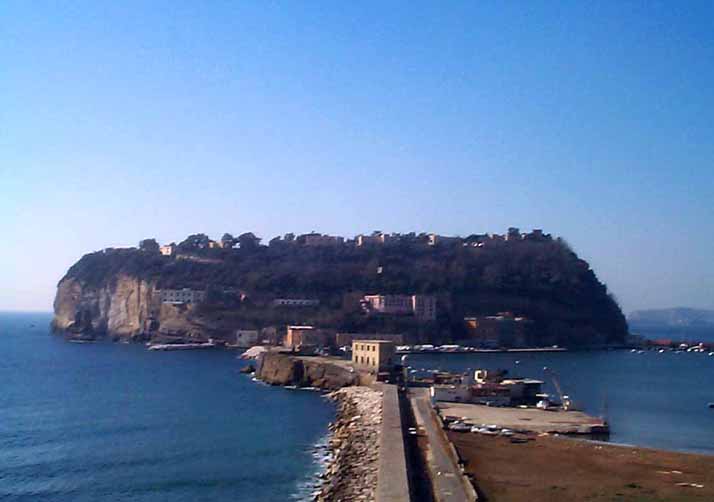 Quite by accident, I discovered a connection between two unrelated
items (or so I thought) in Naples today. The tiny island off the tip
of Cape Posillipo is named Nisida. The original Greek settlers of the
area called this small island Nesis. The Romans called it Nisida.
It is here that Brutus plotted the assassination of Julius Caesar, and
it is here that Cicero says apud illum multas horas in Néside—that
he had a long talk with Brutus after the assassination to discuss the
future of Rome. In the 1800s Nisida was the site of a Bourbon prison,
then an Italian state penitentiary, and, now, a reformatory for juvenile
offenders. Quite by accident, I discovered a connection between two unrelated
items (or so I thought) in Naples today. The tiny island off the tip
of Cape Posillipo is named Nisida. The original Greek settlers of the
area called this small island Nesis. The Romans called it Nisida.
It is here that Brutus plotted the assassination of Julius Caesar, and
it is here that Cicero says apud illum multas horas in Néside—that
he had a long talk with Brutus after the assassination to discuss the
future of Rome. In the 1800s Nisida was the site of a Bourbon prison,
then an Italian state penitentiary, and, now, a reformatory for juvenile
offenders.
Statue
of Carlo Poerio in Piazza S. Pasquale
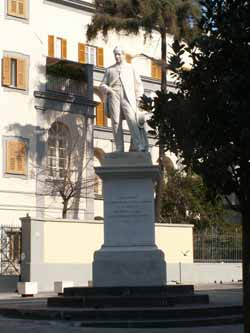 In the early
1900s Nisida suffered two indignities: one, it was joined to the mainland
by a causeway, and, two, it was encroached upon by the unsightly steel
industry in Bagnoli. That patch of industrial blight is (as of 2002)
a thing of the past, as the Campania region and the city of Naples pursue
plans to rejuvenate the entire Bagnoli area. Most of the physical plant
of the ex-steel mill has already been torn down, and there is already
a thriving "Science City" fair ground on the premises in Bagnoli. Currently,
part of the island of Nisida is also home to the administrative headquarters
of NAVSOUTH, the naval forces for NATO's Southern Command. Also, there
is currently some hope of luring the next America's Cup to the area.
That would require major investment in port facilities. At present,
there is a small port for pleasure craft, and that is where I found
myself this morning, helping my friend, Bill, get his splendid sailboat,
Down East, into the water and noticing how uneasy I am with such
phrases as "Avast!" "Belay that!" and "Batten down the hatches!" ("Stand
by to repel boarders!" did give me a thrill just to pronounce, though.
I think it even shivered my timbers.) In the early
1900s Nisida suffered two indignities: one, it was joined to the mainland
by a causeway, and, two, it was encroached upon by the unsightly steel
industry in Bagnoli. That patch of industrial blight is (as of 2002)
a thing of the past, as the Campania region and the city of Naples pursue
plans to rejuvenate the entire Bagnoli area. Most of the physical plant
of the ex-steel mill has already been torn down, and there is already
a thriving "Science City" fair ground on the premises in Bagnoli. Currently,
part of the island of Nisida is also home to the administrative headquarters
of NAVSOUTH, the naval forces for NATO's Southern Command. Also, there
is currently some hope of luring the next America's Cup to the area.
That would require major investment in port facilities. At present,
there is a small port for pleasure craft, and that is where I found
myself this morning, helping my friend, Bill, get his splendid sailboat,
Down East, into the water and noticing how uneasy I am with such
phrases as "Avast!" "Belay that!" and "Batten down the hatches!" ("Stand
by to repel boarders!" did give me a thrill just to pronounce, though.
I think it even shivered my timbers.)
Later in
the day, I was looking for an address on via Poerio in Naples.
Now, just as you can get lost in Naples by going to the wrong via
Caracciolo (see here), so, too, can
you wind up on the wrong via Poerio. There is one named for Carlo
Poerio (1802-67) and another for Alessandro Poerio (1802-1848). They
were brothers, both intimately connected with the Risorgimento,
the political movement to unify Italy. Interestingly, their father,
Giuseppe Poerio (1775-1843) was a supporter of the Neapolitan Republic
of 1799, for which he was sentenced to life in prison. A family of trouble-makers,
clearly.
On
the slopes of the Nisida crater are the ruins of what is thought
to be the villa of Brutus. In the background are the town
of Bagnoli, then Cape Posillipo, then Mt. Vesuvius in the distance.
|
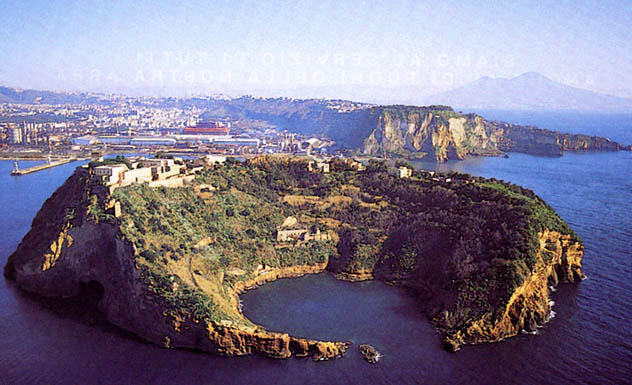 In
1849, Carlo Poerio was sentenced by the Bourbon court of Naples to 24
years at hard labor for his part in the political turmoil in Naples
of the previous year. He was sent to—here is the connection—Nisida.
He and other prisoners were confined in such miserable conditions that
William Gladstone, after a visit to the prison in 1851, felt compelled
to write his two Letters to the Earl of Aberdeen on the State Prosecutions
of the Neapolitan Government. In these letters, Gladstone coined
the now famous description of the Kingdom of Two Sicilies as "the negation
of God erected into a system of Government." Indignation throughout
Europe was partially responsible for Poerio's release in 1858. He was
exiled but returned to Italy in 1861. He died that year in Florence.
[For more on the Gladstone "Letters...," click
here.] In
1849, Carlo Poerio was sentenced by the Bourbon court of Naples to 24
years at hard labor for his part in the political turmoil in Naples
of the previous year. He was sent to—here is the connection—Nisida.
He and other prisoners were confined in such miserable conditions that
William Gladstone, after a visit to the prison in 1851, felt compelled
to write his two Letters to the Earl of Aberdeen on the State Prosecutions
of the Neapolitan Government. In these letters, Gladstone coined
the now famous description of the Kingdom of Two Sicilies as "the negation
of God erected into a system of Government." Indignation throughout
Europe was partially responsible for Poerio's release in 1858. He was
exiled but returned to Italy in 1861. He died that year in Florence.
[For more on the Gladstone "Letters...," click
here.]
Swiss
in Naples
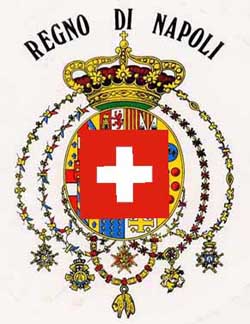 In
the 1949 thriller, The Third Man, Orson Welles' character, Harry
Lime, delivers a short monologue on Switzerland: In
the 1949 thriller, The Third Man, Orson Welles' character, Harry
Lime, delivers a short monologue on Switzerland:
| In
Italy for thirty years under the Borgias they had warfare, terror,
murder, bloodshed —but they produced Michelangelo, Leonardo
da Vinci, and the Renaissance. In Switzerland they had brotherly
love, 500 years of democracy and peace, and what did that produce?
The cuckoo clock. |
With all
due respect to Welles (he wrote that part of the script, himself),
the idea that the Swiss are a peaceful race of bankers, yodellers,
and clock makers is wrong. In modern-day Switzerland, every male who
is upright and breathing is in the army until the age of 50. They
all keep their military-issue weapons at home, and, I suspect, rank
high in the world on the firearm-per-square-person index.
True, when
one thinks of Swiss soldiers and Italy, the colourful Swiss guards in
the Vatican in their 16th–century uniforms pop to mind (photo,
left below). Yet, behind today's quaint picture of comic-opera irrelevance
is a very long and violent history of Switzerland as the single greatest
provider of mercenary soldiers in Europe. Between the Battle of Nancy
in 1477 and 1874, when the Swiss constitution forbade the practice,
regiment after regiment of Swiss soldiers fought on battlefields elsewhere
in Europe. These were not individual "hired guns," but entire regular
Swiss regiments contracted out by their respective cantonal governments
to serve abroad in return for large sums of money, a substantial part
of the income in a canton in any given year. In 400 years of mercenary
service, Switzerland hired out some two million soldiers and 70,000
officers.
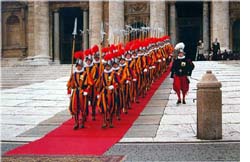 The contracts
were typically between a canton and a particular monarch, whom the Swiss
were then expected to serve faithfully, no matter what. For that reason,
you always have Swiss Guards on the side of established order and never
on the side of revolution. One famous episode was during the defence
(Aug. 10, 1792) of the Tuileries palace in Paris during the French Revolution.
Louis XVI ordered the Swiss Guard not to fire on the crowd, which, at
the goading of George Danton, stormed the palace and massacred 600 of
them, anyway. The contracts
were typically between a canton and a particular monarch, whom the Swiss
were then expected to serve faithfully, no matter what. For that reason,
you always have Swiss Guards on the side of established order and never
on the side of revolution. One famous episode was during the defence
(Aug. 10, 1792) of the Tuileries palace in Paris during the French Revolution.
Louis XVI ordered the Swiss Guard not to fire on the crowd, which, at
the goading of George Danton, stormed the palace and massacred 600 of
them, anyway.
The Swiss
were very active in Naples from the beginning of the Bourbon rule in
the 1730s right up until the final defence of the Kingdom of Two Sicilies
at the siege of Gaeta in 1860. Their first contract with Naples was
in 1731 with Charles III of Bourbon and
by the mid-1800s there were four regiments (about 7,500 men) of Swiss
on constant service in the Kingdom of Naples.
The Swiss
were important in the Kingdom of Naples in the turbulent year of 1848,
when calls for reform and revolution swept virtually all of Europe.
In January of that year, there was an uprising in Sicily, and a call
for the restitution of their constitution of 1812. (In that year, the
mainland portion of the Kingdom of Naples was in French hands, under
Murat, while the Bourbon monarchy with their royalist
troops and Swiss Guard were holed up on Sicily, protected by the British
fleet. The Bourbons granted, with British encouragement, a constitution
to their subjects on Sicily. That constitution extended to the rest
of the Kingdom when it was retaken in 1814, but it was revoked by Ferdinand
I after the riots of 1821.) In 1848, Sicily also declared its independence
from the Kingdom of Naples. Ferdinand II
of Naples—by any account an absolutist and becoming more and
more so the longer this talk of a "united Italy" continued—obviously
wouldn't buy the part about independence, but he did feel compelled
to grant another constitution of sorts.
That put
the situation in limbo for a few months. Then, in April, Ferdinand declared
war on Austria, a move—had things gone differently in the "what-if"
school of history—that would have put him on the same side as
the Savoys of Piedmont—a united Italian army. That was not to
be. Banal events in Naples the next month involving the form of a parliamentary
oath of office led to Ferdinand closing the parliament, revoking the
constitution, and recalling his troops from the north. In May an uprising
took place in the city of Naples, and Ferdinand relied heavily on his
Swiss Guards to suppress it. The four Swiss regiments in the city lost
a total of 205 troops in the single day of combat in the city and came
under severe criticism for their brutality, investigations of which
were conducted even by the respective cantonal governments back in Switzerland.
Sicily, by that time, was in full revolt, and later in the year, the
Swiss sent their Neapolitan regiments as an expeditionary force to help
quell the revolt on the island. That took until early 1849. The Sicilian
episode included the infamous bombardment of Messina, an act that earned
Ferdinand II of Naples the nickname of "la bomba" for the rest
of his life.
Throughout
the 1850s, the Swiss Guards helped to prop up the Bourbon monarchy.
They stood by their contract even at the end—the hopeless defence of Gaeta in late 1860 and early 1861 in
the face of the overwhelming forces of Victor Emmanuel II. Those
that survived accompanied the defeated Bourbon king, Francis II, into
exile.
Catacombs
(2), Jewish catacombs
There was
a very good article in the New York Times today entitled "In Italian
Dust, Signs of a Past Jewish Life," by Andrée Brooks. It was
about the excavation of Jewish catacombs in Venosa in Puglia, east of
Naples, and also mentioned some of the early Jewish artefacts in the
National Museum and National Library of Naples.
The article
reminded me that I had read a while ago about the existence of Jewish
catacombs in Naples, itself. The source was Guida Insolita ai misteri,
ai segreti, alle leggende e alle curiosità di Napoli Sotteterranea
(Unusual Guide to the Mysteries, Secrets, Legends and Curiosities of
Underground Naples) by Giovanni Liccardo. (Newton & Compton editori,
Rome, 2000.) The author talks a bit about the history of the Jews in
Naples in the seventh century and cites Pope Gregory the Great's admonition
to Bishop Pascasio of Naples in the year 602:
| ...et
de suis illos solemnitatibus inquietari denuo non permittat, sed
omnes festivitates feriasque suas, sicut hactenus ... tenuerunt,
liberam habeant observandi celebrandique licentiam. |
[Essentially,
that Pascasio should stop interfering with the Jews in the practice
of their religious rites and let them freely worship the way they choose.]
The catacombs
were discovered in 1908, and another find was made in the early 1930s
during excavations for a military barracks. Both finds are in the same
area, along the street called via Malta, near the intersection
of via Lahalle. That is in the eastern part of the city—though
well outside of the ancient city of Naples as it existed in the seventh
century. It is an area that has undergone intensive construction in
the last century: the military barracks, mentioned above, as well as
a new elevated roadway leading up from the presumed site of the catacombs
to the Naples Tangenziale, the highway that skirts the northern
edge of the city. Both sites are described as having been found at about
nine feet below the present street level. They both had more than a
single tier of tombs; some were covered by a tiled roof. Inscriptions
indicate that they are from the fifth or sixth century, a.d.
After the
1931 find, the great Neapolitan archaeologist, Amedeo Maiuri remarked
that they were extremely important in terms of learning about the "early
demography of Naples". The bad news is that I couldn't find a trace
of them just a few hours ago—I went down there, map in hand. There
is a huge barracks overarched by the elevated roadway, mentioned above.
I didn't expect a site open to the public the way the Christian catacombs of Naples, but there wasn't
anything, not even an historical marker. I then called up Aldo,
a 90-year friend and one of the oldest members of the Jewish community
in Naples.
He said,
"Do you mean the old Jewish cemetery? I know where that is."
I said, "No. I mean catacombs from right after the fall of the Roman
Empire."
He said, "Never heard of them."
As they
say, more research is needed.
|
